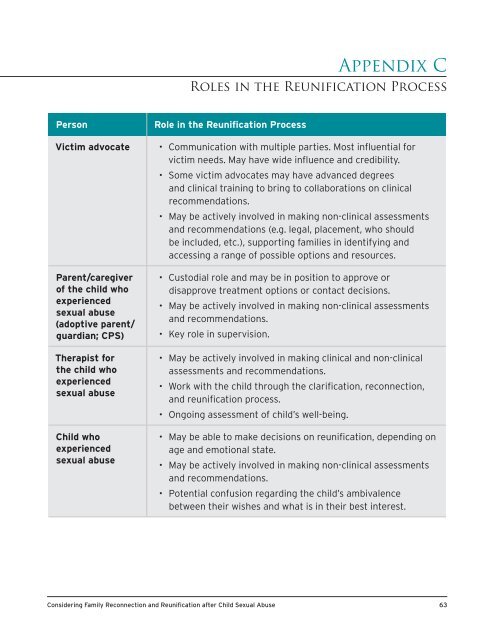Considering Family Reconnection and Reunification after Child Sexual Abuse
1VwGeds
1VwGeds
You also want an ePaper? Increase the reach of your titles
YUMPU automatically turns print PDFs into web optimized ePapers that Google loves.
Appendix C<br />
Roles in the <strong>Reunification</strong> Process<br />
Person<br />
Victim advocate<br />
Parent/caregiver<br />
of the child who<br />
experienced<br />
sexual abuse<br />
(adoptive parent/<br />
guardian; CPS)<br />
Therapist for<br />
the child who<br />
experienced<br />
sexual abuse<br />
<strong>Child</strong> who<br />
experienced<br />
sexual abuse<br />
Role in the <strong>Reunification</strong> Process<br />
• Communication with multiple parties. Most influential for<br />
victim needs. May have wide influence <strong>and</strong> credibility.<br />
• Some victim advocates may have advanced degrees<br />
<strong>and</strong> clinical training to bring to collaborations on clinical<br />
recommendations.<br />
• May be actively involved in making non-clinical assessments<br />
<strong>and</strong> recommendations (e.g. legal, placement, who should<br />
be included, etc.), supporting families in identifying <strong>and</strong><br />
accessing a range of possible options <strong>and</strong> resources.<br />
• Custodial role <strong>and</strong> may be in position to approve or<br />
disapprove treatment options or contact decisions.<br />
• May be actively involved in making non-clinical assessments<br />
<strong>and</strong> recommendations.<br />
• Key role in supervision.<br />
• May be actively involved in making clinical <strong>and</strong> non-clinical<br />
assessments <strong>and</strong> recommendations.<br />
• Work with the child through the clarification, reconnection,<br />
<strong>and</strong> reunification process.<br />
• Ongoing assessment of child’s well-being.<br />
• May be able to make decisions on reunification, depending on<br />
age <strong>and</strong> emotional state.<br />
• May be actively involved in making non-clinical assessments<br />
<strong>and</strong> recommendations.<br />
• Potential confusion regarding the child’s ambivalence<br />
between their wishes <strong>and</strong> what is in their best interest.<br />
<strong>Considering</strong> <strong>Family</strong> <strong>Reconnection</strong> <strong>and</strong> <strong>Reunification</strong> <strong>after</strong> <strong>Child</strong> <strong>Sexual</strong> <strong>Abuse</strong> 63


